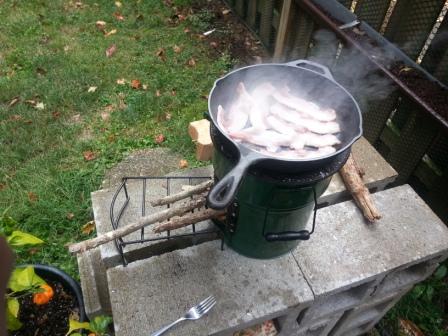
*Cooking on a Rocket Stove*
By: TooshieGalore
14 October 2015
First the bacon goes on. Notice the amount and size of wood coming from the feed door on the left side.

There is no smoke from the fire. The steam is caused after it began to rain. I was cooking holding an umbrella!
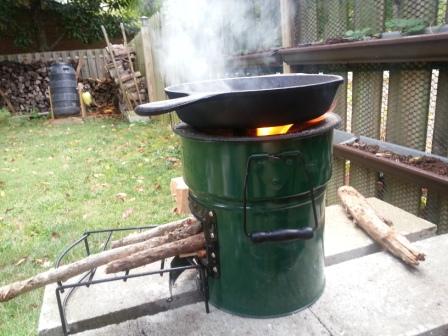
Bacon off; potatoes and onions goes on.
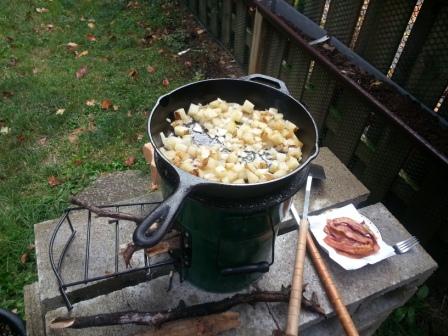
When the potatoes are 3/4 done, I move them to the center, the hottest part of the skillet and pour the scrambled egg mixture around the edges. We're about done. Good thing, the firewood is about used.

Breakfast is served.

I'm completely comfortable cooking on a rocket stove. I feel that I'm in control of the fire. Having a small flame makes me feel more secure than cooking over the open fire at the fire pit. It doesn't produce smoke. I don't choke like on an open fire when the wind changes – the food might steam - but the burning-wood doesn't smoke. When the cooking is done, the ash is completely burned and can be dumped into the garden. I like that it's small and mobile. It weighs about 15 lbs, but I can easily pick it up by its handles and carry indoors to cook on it, in the fireplace.
If you are used to cooking on a gas stovetop, you will feel right at home with a rocket stove. The flame and heat is consistent as long as you feed it. I use it to fry, grill, or steam – anything I would do on my conventional stovetop. This thing will boil water in far less time than a conventional stovetop.
My 10" cast iron frying pan is my go-to rocket stove cookware. You can see how cookware is elevated slightly to allow hot air to escape the "rocket."
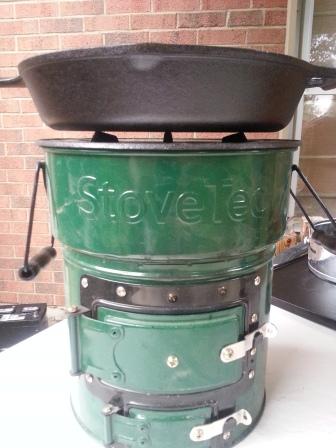
If I want to boil water quickly, this aluminum ring doesn't allow hot air to escape, directing hot air around the pot, heating it up faster. This ring is adjustable for different size pots and came with the unit.
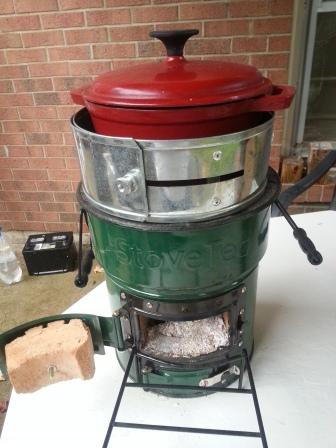
With the feed door open, you can see how much insulation is built into this thing. But insulation is not necessary to preserve heat. Heating comes from the "rocket" design and the way air is drawn into it. Insulation is there to protect the cook. The grate provides a resting place for tinder while it's burning. I prefer to place the grate to the side when cooking so I'm not standing directly in front of the flame.
If I'm cooking something like rice, I prefer to use normal household cookware. I sit a "normal" pot on cast iron. The pot heats up quickly without coming in direct contact with flames.
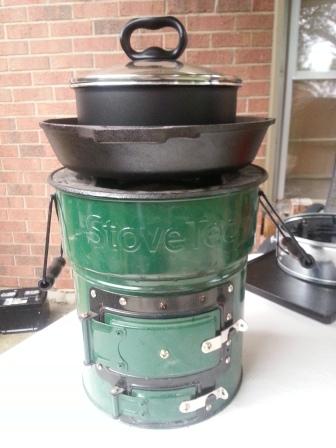
This 18" cast iron griddle is a must-have for grilling meats, potatoes or stir-fry. Hubby likes making pancakes on the griddle.
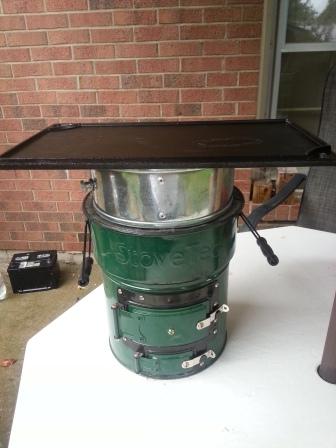
I am astounded at the efficiency of the rocket stove and just how little fuel is required to use it. Most people don't understand how to properly fuel it. The rocket stove requires more air than fuel. Small sticks – no thicker than your thumb works best. Don't over fill the feed; make sure there is plenty of air. The good designs have a damper below the feed door to control air. You can see the dampener below the feed door.
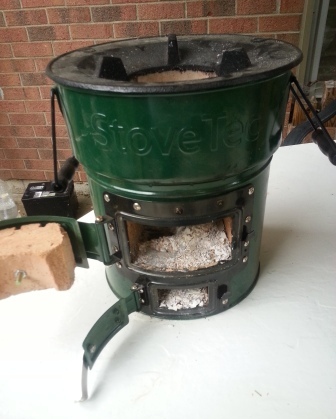
Poorly made rocket stoves may not be properly weighted. If they are not heavy in the base, or otherwise built stable, they are easily knocked over – and then you have an open flame (and hot grease?) being knocked over. Most of them have feed slots that are perpendicular to the flame, which means you have to continually stand there, continuously pushing sticks in to feed the flame. Many are made from metal and prone to corrosion – coastal residents will be happier with a stainless steel unit.
I purchased my StoveTec for about $100 and consider it money well spent. It burns wood, coal (this is KY!), and charcoal. There are newer units on the market today with new features such as a feed slot at a 45-degree angle so that gravity feeds the sticks in as they are burned. This is also easier when using pellets as fuel. Look for good deals on eBay.
A rocket stove is easy to DIY. There are plenty of YouTube videos with instructions.
TooshieGalore
www.alpharubicon.com
All materials at this site not otherwise credited are Copyright © 1996 - 2015 Trip Williams. All rights reserved. May be reproduced for personal use only. Use of any material contained herein is subject to stated terms or written permission.